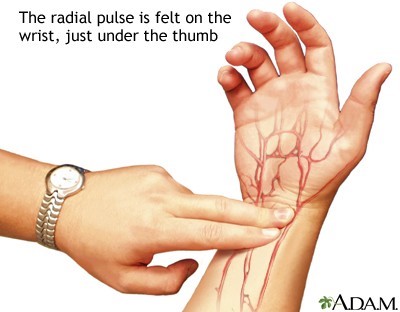When a person’s pulse is taken by palpation near the thumb on the wrist, which artery is felt?
Radial artery.
Palmar arch arteries.
Brachial artery.
Ulnar artery.
The Correct Answer is A

The radial artery is one of the major blood-supplying vessels to the forearm and hand.
It can be felt as a pulse near the thumb on the wrist by gently pressing the artery against the underlying bone.
This is the most commonly measured pulse by nurses to assess peripheral pulse characteristics.
Choice B.
Palmar arch arteries are wrong because these are branches of the radial and ulnar arteries that form anastomosis in the palm of the hand.
They are not palpable on the wrist.
Choice C.
The brachial artery is wrong because this is the main artery of the upper arm that bifurcates into the radial and ulnar arteries at the cubital fossa.
It can be felt as a pulse in the antecubital fossa, not near the thumb on the wrist.
Choice D
The Ulnar artery is wrong because this is another major blood-supplying vessel to the forearm and hand that runs along the medial aspect of the forearm.
It can be felt as a pulse on the little finger side of the wrist, not near the thumb.
Nursing Test Bank
Naxlex Comprehensive Predictor Exams
Related Questions
Correct Answer is B
Explanation
Cardiac output is calculated by multiplying the stroke volume by the heart rate, not by the systolic blood pressure.
Stroke volume is the amount of blood circulated by the heart with each beat. Heart rate is the number of beats per minute.
Systolic blood pressure is the pressure in the arteries when the heart contracts. Choice A is wrong because it confuses systolic blood pressure with heart rate.
Systolic blood pressure is not directly related to cardiac output, although it can be affected by it.
1: Cardiac Output- Definition, Factors Affecting, Cardiac Index - BYJU’S 2: Cardiac Output (Fick’s Formula) - MDCalc 3: Calculating how much blood is pumped by the heart - Cellular respiration and transport - Edexcel - GCSE Biology (Single Science) Revision - Edexcel - BBC Bitesize 4: Cardiac output - Structure and function of the heart - Higher Human Biology Revision - BBC Bitesize : Blood Pressure: What Is Normal? How To Measure Blood Pressure (healthline.com)
Correct Answer is B
Explanation
Naturally acquired active immunity is the type of resistance that is acquired as a result of developing a disease.
This means that the immune system produces antibodies to fight off the infection and remembers the pathogen for future protection.
This type of immunity is long-lasting and sometimes life-long.
Choice A is wrong because naturally acquired passive immunity is the type of resistance that is acquired when a person receives antibodies from another source, such as from the mother through the placenta or breast milk.
This type of immunity is temporary and lasts only for a few weeks or months.
Choice C is wrong because artificially acquired active immunity is the type of resistance that is acquired when a person receives a vaccine that contains a weakened or killed form of the disease organism.
This triggers the immune system to produce antibodies and memory cells without causing the actual disease.
This type of immunity can last for years or decades, depending on the vaccine.
Choice D is wrong because artificially acquired passive immunity is the type of resistance that is acquired when a person receives antibody-containing blood products, such as immune globulin, that provide immediate protection from a specific disease.
This type of immunity is also temporary and lasts only for a few weeks or months.
Whether you are a student looking to ace your exams or a practicing nurse seeking to enhance your expertise , our nursing education contents will empower you with the confidence and competence to make a difference in the lives of patients and become a respected leader in the healthcare field.
Visit Naxlex, invest in your future and unlock endless possibilities with our unparalleled nursing education contents today
Report Wrong Answer on the Current Question
Do you disagree with the answer? If yes, what is your expected answer? Explain.
Kindly be descriptive with the issue you are facing.
